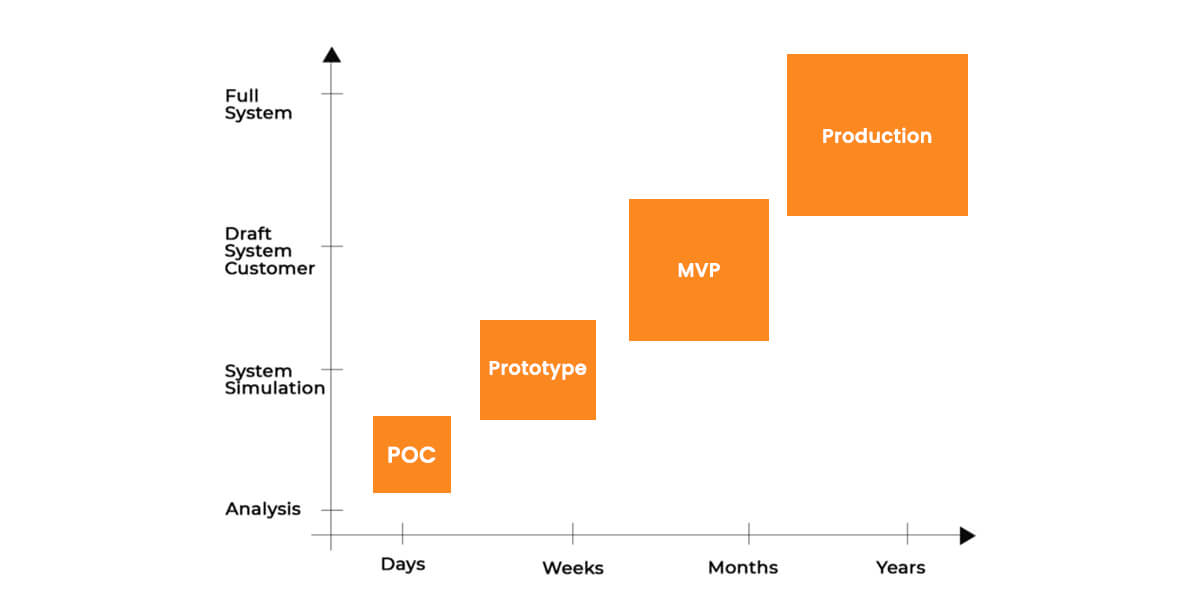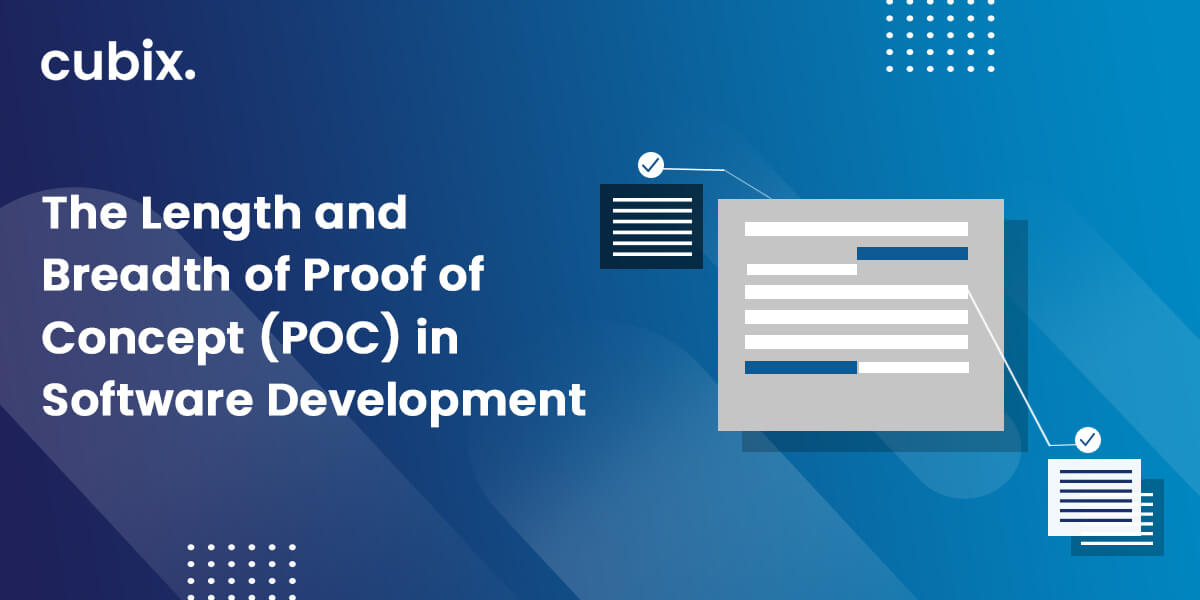Every project needs a product development strategy that's thoroughly analyzed and well-researched if we expect incredible results. Especially when it comes to the software product development process, it sounds like you have "innovation in your hand," but you don't know the technicalities, strategies, approaches, risks, challenges, etc. When a refined digital product comes into existence, its robustness and fully functional abilities speak volumes of its quality.
But how product development strategy blends all the crucial aspects of product success is something to debate about. Therefore, let's get into the in-depth details of how successful software development is achieved.
PoC in Software Development
Many wide-ranging digital product development companies don't really consider Proof of Concept before starting a project regardless of its size. A proof of concept determines and verifies the digital product development idea and provides a path to the product manager with an exceptional approach to initiate the process. PoC helps you identify the worth of the product in the real-world market before beginning the product development process.
Proof of concept highlights the fundamental insight about the project, permits the product owner and workforce to define the success criteria, and enables the team to make decisions for building the product accordingly. In short and precise words, Proof of concept (POC) supports and gives the base of product prototypes and MVPs developments.
Proof of concept represents the idea and functionalities of the proposed product and its worth in the real-world market. When a team intends to build MVPs and prototypes, they need basic information, development data, and estimations regarding cost, customer interest, timeframe, and other crucial elements. This is why PoC is pivotal for building a quality product from the start.
Purpose of Proof of Concept
PoC provides orientation and gives a vision about product development to the technical workforce, which leads them in the right direction for project development. A software development process comprises many risk-involved development stages, challenges, disagreements, rejections, constraints, and whatsoever.
This is why critical thinking is essential in the form of Proof of concept (PoC) and why PoC is called "proof of concept" – a team with a clear concept with existing Proof that the idea is worth implementing in the official project.
Quick Cost and Time Estimation
The critical phase in project analysis arises when product owners and project managers get into the estimations. Many confusions arise when the product owner wants the completed product in 6 months. But the project manager predicts 7 to 8 months for project completion (with his past development experience), and the product development workforce asks for at least a year to finish and deploy the project.
Indeed, business decisions are highly dependent on estimations. Therefore, when the estimations are made, the concerned authorities consider the future of the product and where it will be standing in the next ten years. However, the business fails because of the reasons like uncertainty source in software business decisions. Why does uncertainty arise? It arises due to:
Proof of Concept - A Foundation for Prototypes and MVPs?
Companies often consider the software development planning phase and making prototypes the same. This is why they don't build profound prototypes, so they fail to hit the target. So, the PoC practice should include the idea of resources feasibility and determine the best possible technical path for quality product development.
Prototypes represent the early versions of a digital product that help the team check the design and overall functioning capability. The team demonstrates the product's visual appearance, the user experience (UX), and test features that need to be implemented or deleted.
On the contrary, minimum viable products (MVPs) encompass limited features for early adopters. The product development team then proceeds with an actual project based on the feedback given by early users. Once the project manager and the development team get positive feedback, the detailed project development cycle initiates until the project gets deployed.
Leveraging Aspects of Proof of Concept

The PoC verifies the idea, strategies, and theories essential for successful software product development. It highlights the core issue and the feasibility of the product development.
Key Steps for Proof of Concept?
Often professionals also mix up the Software requirement specification (SRS) documents and Proof of concept, which are entirely two different considerations in the software development process. As a result, PoC is developed and required in the very initial stage – even before building prototypes, MVPs, and SDLC.
SRS is used in the project analysis phase and does encompass the project requirements will be highly dependent. It provides a thorough overview of the proposed digital product and goals. It defines the UI/UX, development, functionality, hardware, and software, network requirements essential to fulfill the need of concerned authorities (stakeholders, customers, users). SRS is created when the team is amid the software development lifecycle (SDLC).
1# Elaborate Requirements
Every idea needs real-life support to come into existence in the form of a robust and fully functional product that works for years. Therefore, a very initial stage of PoC encourages project managers and development teams to analyze real-world problems that the proposed software aims to solve.
Raise and answer the questions while analyzing the cruciality of requirements; what value will this product add to users? Why are we developing this project? What can we achieve from this project? What available resources do we have? How to implement software product development in the planned strategies?
And the truth is, smart developers never stop questioning throughout the process to implement their expertise in the best possible manner.
2# Build Solutions
What would be the best and smart solutions to the problems? This proof-of-concept stage finds result-driven solutions for problems and pain points. Moreover, you can also take your competitors in the loop to find answers to your relevant solutions. Involve veteran developers because they can answer your questions with their experience and tested strategies that they find leveraging in their development journey.
3# Build Prototype
This stage encourages the team to demonstrate the structure and architecture of the proposed product through wireframes, product sketches, product features, UI/UX design, etc. This PoC stage shapes your product idea under discussion and research in the previous phases.
4# Gather User Feedback
To test the first-ever product design and its appearance, ask your potential audience to give an honest review. This stage involves stakeholders and potential users to gather data about the modifications users want to make and ensure the development team that the project is worthy enough to develop and launch in the market.
This stage of feedback and review helps you improvise the strategies and approach to development and elaborate the details about features you neglected. Hence, user feedback gives insight into what's exceptional for project development and what's not? To that end, you build a strong foundation at the very beginning, which lowers the probability of failures to a greater extent.
5# Document your gatherings
Gather and save all crucial information and project development data to make a roadmap that guides you throughout the development journey. The document should outline the essential steps concerning each phase of the software development life cycle; planning, designing, development, testing, deployment, and post-launch maintenance.
When to Communicate with Client?
Always and throughout the software development cycle! However, some project development approaches like traditional project management involve their concerned client only in the planning phase, resulting in longer development time and exceeded budget and the unhappy product owner.
On the other side, the Agile project management approach involves the client throughout the SDLC. As a result, more robust and high-quality products came into existence along with happy and satisfied product owners.
It is advised to involve the product owner in the Proof of concept (PoC) so that both parties will have clarity and the project will be built on the mutual agreements and understanding.
We Love Developing Your Software Product with PoC
Clients from all over the world come to Cubix for wide-ranging software product development. Some of the projects we receive require up-gradations and improvisions according to the trending tech stack in the market, and many other clients ring the bell to develop the project from scratch.
To build and deploy a successful project that amazingly fulfills the client's demand, we take our client into a loop in the proof-of-concept stage. We would be happy if you, just like others, trusted and handed their project to us.
We aim to see our clientele ahead in the technological world, and therefore we develop projects with great zeal and untiring efforts. As proof, our portfolio is a practical representation of who we are as a software development company.
Want to know which frameworks and technologies we use to develop the top-notch product? Visit one of the most visited websites in the software development world.

